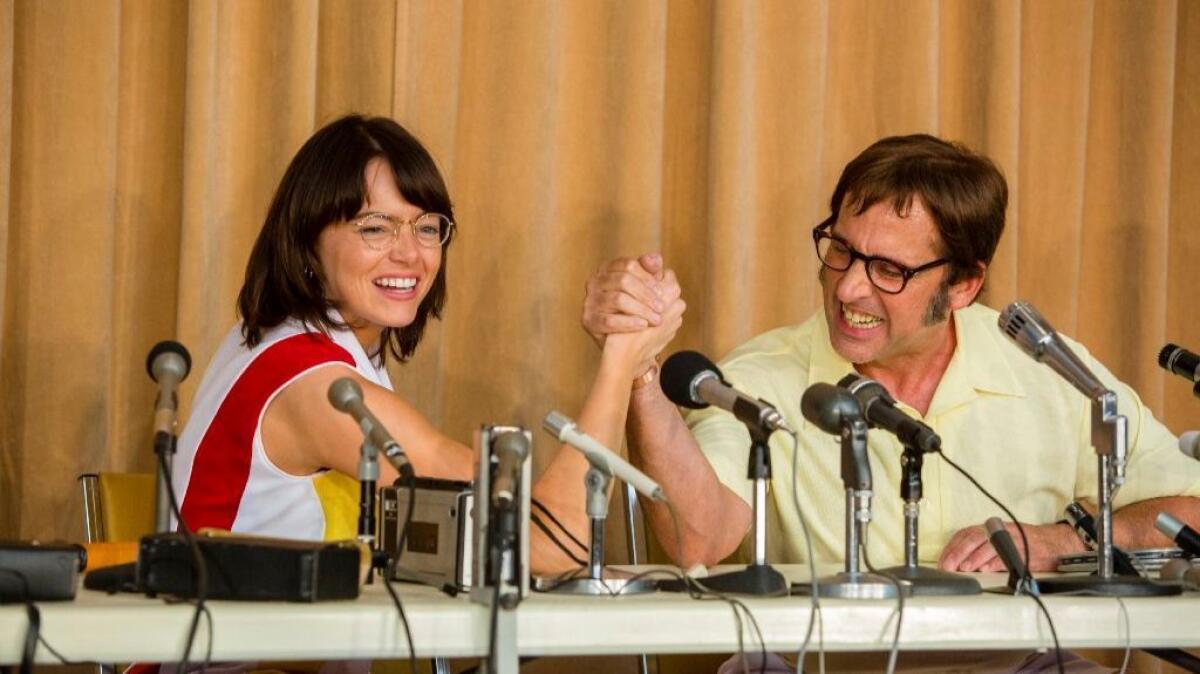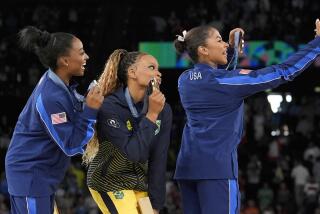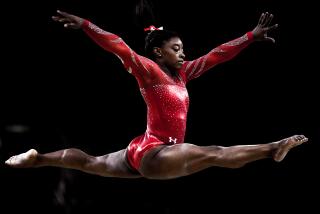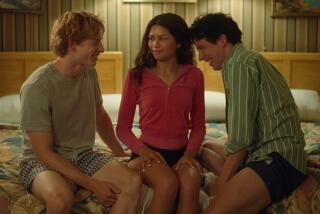How tennis’ Battle of the Sexes did — and didn’t — change the game

- Share via
In a key scene late in “Battle of the Sexes,” the new tennis movie about the landmark Billie Jean King-Bobby Riggs match, an icon is reminded of her power to influence.
“Times change,” King, played by Emma Stone, is told by a confidante. “You should know — you just changed them.”
The 1973 exhibition, which pitted tennis great King against the 55-year-old champion from an earlier time, certainly was a study in contrasts — the trailblazer and the showman, the chauvinist and the progressive, the old guard and the new world.
How much it altered the face of the game has a more ambiguous answer. Did the highly symbolic, intensely circus-like event usher in a new era not just in tennis but in sports, not just in gender equity but in areas like celebrity and playability? And if it did, how is the world better off for it?
With the Jonathan Dayton-Valerie Faris picture making an implicit case for the match’s positive influence, we decided to explore the matter further. Tennis is a uniquely solitary sport, far more about a competitor’s battle with himself than with his opponent. But we cheated a little and sought some coaching. Figures from the movie, including Stone and co-star Steve Carell, tennis expert Jon Wertheim, even King herself — all helped us make calls on a match’s legacy, on where tennis finds itself and how it got here.
Race and sexuality
At the heart of professional tennis lies a paradox. The sport has always had a more progressive reputation than its counterparts. It boasted top-flight female professionals decades ahead of most team sports; it counts social-activist pioneers like Arthur Ashe among its ranks. And tennis was a global melange of cultures long before the NBA and MLB moved in that direction.
And yet, to play the game is to require resources. Historically the champions have come from money, and often are white.
That contradiction is captured by the Battle of the Sexes itself. On one hand, the match, which King won easily in straight sets, struck a blow for gender equality. Yet the exhibition highlighted and brought out chauvinist elements, epitomized by the promoter Jack Kramer (Bill Pullman at his unctuous best in the film) and some famous spectators who cringingly touted men’s superiority.
So which view of the game is now more accurate, nearly a half-century after the match?
Certainly the modern era has brought some issues in this regard. Yes, the sport can at times feel like it exists in a bubble. The champion Martina Hingis, who continues her long reign with a spate of double titles, made homophobic remarks about the retired top player, Amelie Mauresmo, a lesbian, at Roland Garros some years ago. And some deep pockets are still needed to compete at various levels, initiatives like the USTA’s youth programs notwithstanding.
The overall picture, though, remains stronger than the popular view.
“I think tennis needs a publicist just to deal with these issues,” said Wertheim, the Sports Illustrated executive editor and ESPN commentator who has written numerous books about tennis. Trans pioneer “Renée Richards preceded Caitlyn Jenner by decades. Long before Jason Collins [came out while playing in the NBA] there was Martina Navratilova. Tennis is very progressive, yet it’s held up as this country-club redoubt, white, elitist sport.”
Indeed, the Williams sisters have ushered in a new era of fans and competitors — witness both the women’s and girls’ finals at the U.S. Open this year, which had exclusively African American players.
And the idea of tennis as a sport for the aristocracy has eroded too, as champions like Andy Murray and Novak Djokovic, along with the Williams sisters, come from more hardscrabble backgrounds. “Go down the list of the top players, where they come from and how they came to the game,” Wertheim said. “The idea of it as this ‘Trading Places’ [scene of] ‘and then he stepped on the ball’ just isn’t true anymore.”
Equal pay
The ’73 match didn’t happen in a vacuum. King and other women’s players had been waging a fight for equal pay on the tour — one smaller tournament was set to pay men eight times as much as women in prize money, prompting the women to start their own tour, the Virginia Slims Circuit, which would evolve into the present-day Women’s Tennis Assn. (WTA).
When King accepted the challenge from Riggs, it was to popularize the equal-pay cause and pressure tournament organizers, particularly at the Slams, to bring money into gender alignment.
Prize money at the majors is now equal. But don’t let the movie trick you into thinking the Battle of the Sexes was an immediate force for change. It took some of the Slams decades for men and women to earn equal prize money: Wimbledon, the last tournament to do so, didn’t change its policy until 2007.
As recently as last year the head of the BNP Paribas Open in Indian Wells questioned women’s contributions to the game. “They ride on the coattails of men,” the CEO and tournament director Raymond Moore said, adding that, if he was a female player, he’d “go down every night on my knees and thank God that Roger Federer and Rafael Nadal were born.”
He was widely condemned and subsequently resigned. But the fact “that this movie is relevant is what’s so sad, isn’t it?” Carell said, referring to gender-equality issues across multiple realms.
Stone looked at the bright side of the issue. “It’s relevant to see a film like this because these are the shoulders on which we now stand” in the fight for equal pay, she said.
Nor should one think only in terms of prize money: Endorsements, where many players make the bulk of their money, are an area of disparity too. Studies routinely show sponsor dollars for women can come in at a fraction of those for the top female players. A couple of years ago Caroline Wozniacki and Nadal, though each ranked third ,were separated by $18 million in earnings ($33 million to $14 million).
“There should be a lot more shoe deals; there should be deals with Adidas and Nike and so many other brands,” King said. “We still don’t get as much as the men do because of the old-boy network.”
Playing style
Fans of the game who watch the movie’s third-act tennis scenes will be struck by the playing styles. Riggs and King win most of their points at the net, serving-and-volleying or approaching at will, in contrast to today’s free-swinging baseliners who used the volley as a change-of-pace strategy, if they come to the net at all.
There is also no shortage of slices, lobs, and carved-out drop shots. This is tennis at wood-era stylish best. Today’s power game —influenced by increased fitness and, particularly, racket technology — is nowhere to be found. In this respect the match feels most in-period. “Tennis then has as much to do with tennis today as Cy Young has to with Clayton Kershaw,” Wertheim said.
An equally notable shift in the court happenings? Who’s on it.
“The biggest thing that came out of the match for me were the girls in the stands who felt self-empowered and encouraged,” King said. “Fathers came up with tears in their eyes. And many of their daughters started playing tennis.”
Celebrity
What’s striking watching Dayton and Faris re-create the match is how much of a cult of personality had sprung up around the principals. Rooting for Riggs or King said something about what you stood for —politically, culturally, philosophically.
That has now become de rigueur in tennis: Federer fans see themselves as graceful purists, Nadal supporters relate to the all-out passion; Murray enthusiasts champion the grit and working-class sweat.
“The idea of tennis as representation — I’m a fan of Serena and I may never even have seen her play — I think can be traced to this match,” Wertheim said. The 1960s legend “Rod Laver was a great but I don’t know that anyone was saying ‘I’m a fan of Rod Laver and that means something,’ But Riggs and Billie Jean King and [earlier Riggs antagonist] Margaret Court all stood for something, even if you didn’t like what they stood for.”
Whether this increased emphasis on tennis personality is a good thing remains an open question. For every person who embraces the cast of characters, some would say the interest in personalities has detracted from the play itself.
(And whether some of these personality traits have been tamped down in an era of more corporate money and social-media scrutiny is a separate but not a small concern; it’s hard to imagine any player today ever engaging in the kind of bald showmanship that Riggs did.)
Whatever your view, Dayton and Faris accentuate these personal elements in the film; this is clearly a 2017 view on 1973’s events. “I feel like personal change breeds political change,” Faris said of their reasons for making King’s closeted relationship with hairdresser Marilyn Barnett a key part of their story.
“We talked about how a secret identity was beneath her fight for equality, and how that makes the Battle of the Sexes contain not just an important struggle but a fascinating character,” Dayton added.
The movie, it should be said, takes its liberties: In real life the Barnett relationship ended less happily when she sued King for a portion of her assets. And the film elides the question of whether Riggs threw the match for gambling or mob-pressure reasons, a subject of much journalistic inquiry.
But despite those tweaks, the movie underscores an essential truth: The match, improbably, shaped a sport and even a world that was decades away.
“In one sense the match was this kooky one-off, this very ’70’s thing you could make fun of,” said Wertheim. “But it also has all these resonances that continue today.”
Twitter: @ZeitchikLAT
ALSO:
Review: Emma Stone and Steve Carell serve up surprising ‘Battle of the Sexes’
Q&A: Billie Jean King and Emma Stone on ‘Battle of the Sexes’ and the enduring fight for equality
More to Read
Only good movies
Get the Indie Focus newsletter, Mark Olsen's weekly guide to the world of cinema.
You may occasionally receive promotional content from the Los Angeles Times.











